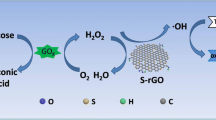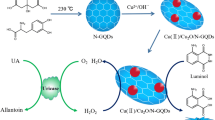Abstract
A facile and green approach to the preparation of peroxidase-like nanozymes by reducing and functionalizing graphene oxide (rGO) with Ganoderma polysaccharide (GP) has been achieved in this work. Our results showed that the as-fabricated nanozyme, namely rGO-GP, possessed the excellent property of simulating peroxidase with higher catalytic activity compared with GO or rGO obtained by using chitosan, which may be due to the better dispersion of rGO-GP in the solution. Steady-state kinetics studies further showed that the catalytic process conformed to Michaelis-Menten equation and ping-pong mechanism. Benefiting from the excellent peroxidase property of rGO-GP, we have also successfully established a highly sensitive and selective colorimetric detection approach to trace detection of l-cysteine (l-Cys). The limit of detection (LOD) of l-cysteine is 0.1 μM and the linear detection range is 2–30 μM. Furthermore, the nanozyme was successfully applied for detecting l-cysteine in serum. This work therefore demonstrates the advantages of rGO-GP as an effective nanozyme in both its green synthesis and detecting application.





Similar content being viewed by others
References
Huang Y, Ren J, Qu X. Nanozymes: classification, catalytic mechanisms, activity regulation, and applications. Chem Rev. 2019;119(6):4357–412.
Wei H, Wang E. Nanomaterials with enzyme-like characteristics (nanozymes): next-generation artificial enzymes. Chem Soc Rev. 2013;42(14):6060–93.
Wu J, Wang X, Wang Q, Lou Z, Li S, Zhu Y, et al. Nanomaterials with enzyme-like characteristics (nanozymes): next-generation artificial enzymes (II). Chem Soc Rev. 2019;48(4):1004–76.
Jv Y, Li B, Cao R. Positively-charged gold nanoparticles as peroxidase mimic and their application in hydrogen peroxide and glucose detection. Chem Commun (Camb). 2010;46(42):8017–9.
Yan X, Song Y, Wu X, Zhu C, Su X, Du D, et al. Oxidase-mimicking activity of ultrathin MnO2 nanosheets in colorimetric assay of acetylcholinesterase activity. Nanoscale. 2017;9(6):2317–23.
Li W, Chen B, Zhang H, Sun Y, Wang J, Zhang J, et al. BSA-stabilized Pt nanozyme for peroxidase mimetics and its application on colorimetric detection of mercury(II) ions. Biosens Bioelectron. 2015;66:251–8.
Ruan X, Liu D, Niu X, Wang Y, Simpson CD, Cheng N, et al. 2D graphene oxide/Fe-MOF nanozyme nest with superior peroxidase-like activity and its application for detection of woodsmoke exposure biomarker. Anal Chem. 2019;91(21):13847–54.
Wang H, Liu C, Liu Z, Ren J, Qu X. Specific oxygenated groups enriched graphene quantum dots as highly efficient enzyme mimics. Small. 2018;14(13):e1703710.
Besteman KLJO, Wiertz FGM. Enzyme-coated carbon nanotubes as single-molecule biosensors. Nano Lett. 2003;3(6):727–30.
Zheng AX, Cong ZX, Wang JR, Li J, Yang HH, Chen GN. Highly-efficient peroxidase-like catalytic activity of graphene dots for biosensing. Biosens Bioelectron. 2013;49:519–24.
Wang H, Wan K, Shi X. Recent advances in nanozyme research. Adv Mater. 2019;31(45):e1805368.
Zhang X, Huang R, Gopalakrishnan S, Cao-Milán R, Rotello VM. Bioorthogonal nanozymes: progress towards therapeutic applications. Trends in Chemistry. 2019;1(1):90–8.
Hasan A, Nanakali NMQ, Salihi A, Rasti B, Sharifi M, Attar F, et al. Nanozyme-based sensing platforms for detection of toxic mercury ions: an alternative approach to conventional methods. Talanta. 2020;215:120939.
Li X, Wang L, Du D, Ni L, Pan J, Niu X. Emerging applications of nanozymes in environmental analysis: opportunities and trends. TrAC Trends Anal Chem. 2019;120.
Huang L, Sun DW, Pu H, Wei Q. Development of nanozymes for food quality and safety detection: principles and recent applications. Compr Rev Food Sci Food Saf. 2019;18(5):1496–513.
Guo Y, Li J, Dong S. Hemin functionalized graphene nanosheets-based dual biosensor platforms for hydrogen peroxide and glucose. Sensors Actuators B Chem. 2011;160(1):295–300.
Liu P, Wang Y, Han L, Cai Y, Ren H, Ma T, et al. Colorimetric assay of bacterial pathogens based on Co3O4 magnetic nanozymes conjugated with specific fusion phage proteins and magnetophoretic chromatography. ACS Appl Mater Interfaces. 2020;12(8):9090–7.
Wen Y, Yan L, Ling Y-C. The designing strategies of graphene-based peroxidase mimetic materials. SCIENCE CHINA Chem. 2017;61(3):266–75.
Song Y, Qu K, Zhao C, Ren J, Qu X. Graphene oxide: intrinsic peroxidase catalytic activity and its application to glucose detection. Adv Mater. 2010;22(19):2206–10.
Sun Y, Wu Q, Shi G. Graphene based new energy materials. Energy Environ Sci. 2011;4(4):1113–32.
Hu M, Yao Z, Wang X. Graphene-based nanomaterials for catalysis. Ind Eng Chem Res. 2017;56(13):3477–502.
Wu K, Feng Y, Li Y, Li L, Liu R, Zhu L. S-doped reduced graphene oxide: a novel peroxidase mimetic and its application in sensitive detection of hydrogen peroxide and glucose. Anal Bioanal Chem. 2020;412(22):5477–87.
Niyogi SBE, Itkis ME. Solution properties of graphite and graphene. J Am Chem Soc. 2006;128(24):7720–1.
Lu L-M, Qiu X-L, Zhang X-B, Shen G-L, Tan W, Yu R-Q. Supramolecular assembly of enzyme on functionalized graphene for electrochemical biosensing. Biosens Bioelectron. 2013;45:102–7.
Khan M, Al-Marri AH, Khan M, Shaik MR, Mohri N, Adil SF, et al. Green approach for the effective reduction of graphene oxide using Salvadora persica L. Root (Miswak) Extract. Nanoscale Res Lett. 2015;10(1):987.
Zhu C, Guo S, Fang Y, Dong S. Reducing sugar: new functional molecules for the green synthesis of graphene nanosheets. ACS Nano. 2010;4(4):2429–37.
Zhang S, Yang K, Feng L, Liu Z. In vitro and in vivo behaviors of dextran functionalized graphene. Carbon. 2011;49(12):4040–9.
Shao CS, Zhou XH, Zheng XX, Huang Q. Ganoderic acid D induces synergistic autophagic cell death except for apoptosis in ESCC cells. J Ethnopharmacol. 2020;262:113213.
Ma Y, Zhang Q, Zhang Q, He H, Chen Z, Zhao Y, et al. Improved production of polysaccharides in Ganoderma lingzhi mycelia by plasma mutagenesis and rapid screening of mutated strains through infrared spectroscopy. PLoS One. 2018;13(9):e0204266.
Ma Y, He H, Wu J, Wang C, Chao K, Huang Q. Assessment of polysaccharides from mycelia of genus Ganoderma by mid-infrared and near-infrared spectroscopy. Sci Rep. 2018;8(1):10.
Zhang S, Zhang D, Sysoev VI, Sedelnikova OV, Asanov IP, Katkov MV, et al. Wrinkled reduced graphene oxide nanosheets for highly sensitive and easy recoverable NH3 gas detector. RSC Adv. 2014;4(87):46930–3.
Shao Y, Wang J, Engelhard M, Wang C, Lin Y. Facile and controllable electrochemical reduction of graphene oxide and its applications. J Mater Chem. 2010;20(4):743–8.
Shen Y, Zhang H-B, Zhang H, Ren W, Dasari A, Tang G-S, et al. Structural evolution of functionalized graphene sheets during solvothermal reduction. Carbon. 2013;56:132–8.
Yang H, Shan C, Li F, Han D, Zhang Q, Niu L, et al. Chem Commun (Camb). 2009;(26):3880–2.
Tuinstra F, Koenig JL. Raman spectrum of graphite. J Chem Phys. 1970;53(3):1126–30.
Tran DNH, Kabiri S, Losic D. A green approach for the reduction of graphene oxide nanosheets using non-aromatic amino acids. Carbon. 2014;76:193–202.
Ye M, Qiu T, Peng W, Chen W-X, Ye Y-W, Lin Y-R. Purification, characterization and hypoglycemic activity of extracellular polysaccharides from Lachnum calyculiforme. Carbohydr Polym. 2011;86(1):285–90.
Chen Y, Xie M-Y, Nie S-P, Li C, Wang Y-X. Purification, composition analysis and antioxidant activity of a polysaccharide from the fruiting bodies of Ganoderma atrum. Food Chem. 2008;107(1):231–41.
Feng J, Feng N, Tang QJ, Liu YF, Yang Y, Liu F, et al. Optimization of Ganoderma lucidum polysaccharides fermentation process for large-scale production. Appl Biochem Biotechnol. 2019;189(3):972–86.
Fraga I, Coutinho J, Bezerra RM, Dias AA, Marques G, Nunes FM. Influence of culture medium growth variables on Ganoderma lucidum exopolysaccharides structural features. Carbohydr Polym. 2014;111:936–46.
Yin R, Shen P, Lu Z. A green approach for the reduction of graphene oxide by the ultraviolet/sulfite process. J Colloid Interface Sci. 2019;550:110–6.
Kuila T, Bose S, Khanra P, Mishra AK, Kim NH, Lee JH. A green approach for the reduction of graphene oxide by wild carrot root. Carbon. 2012;50(3):914–21.
Hu Y, He L, Ding J, Sun D, Chen L, Chen X. One-pot synthesis of dextran decorated reduced graphene oxide nanoparticles for targeted photo-chemotherapy. Carbohydr Polym. 2016;144:223–9.
Gao L, Zhuang J, Nie L, Zhang J, Zhang Y, Gu N, et al. Intrinsic peroxidase-like activity of ferromagnetic nanoparticles. Nat Nanotechnol. 2007;2:577–83.
Chen J, Ge J, Zhang L, Li Z, Zhou S, Qu L. PSS-GN nanocomposites as highly-efficient peroxidase mimics and their applications in colorimetric detection of glucose in serum. RSC Adv. 2015;5(110):90400–7.
Boruah PK, Das MR. Dual responsive magnetic Fe3O4-TiO2/graphene nanocomposite as an artificial nanozyme for the colorimetric detection and photodegradation of pesticide in an aqueous medium. J Hazard Mater. 2020;385:121516.
Sur UKSA, Datta A. Synthesis and characterization of stable aqueous dispersions of graphene. Bull Mater Sci. 2016;39(1):159–65.
Li J, Zhang Y, Zhang X, Huang J, Han J, Zhang Z, et al. S, N dual-doped graphene-like carbon nanosheets as efficient oxygen reduction reaction electrocatalysts. ACS Appl Mater Interfaces. 2017;9(1):398–405.
Liu Y, Lv X, Hou M, Shi Y, Guo W. Selective fluorescence detection of cysteine over homocysteine and glutathione based on a cysteine-triggered dual Michael addition/retro-aza-aldol cascade reaction. Anal Chem. 2015;87(22):11475–83.
Yao G, Huang Q. DFT and SERS study of l-cysteine adsorption on the surface of gold nanoparticles. J Phys Chem C. 2018;122(27):15241–51.
Singh M, Weerathunge P, Liyanage PD, Mayes E, Ramanathan R, Bansal V. Competitive inhibition of the enzyme-mimic activity of Gd-based nanorods toward highly specific colorimetric sensing of l-cysteine. Langmuir. 2017;33(38):10006–15.
Wu X-Q, Xu Y, Chen Y-L, Zhao H, Cui H-J, Shen J-S, et al. Peroxidase-like activity of ferric ions and their application to cysteine detection. RSC Adv. 2014;4(110):64438–42.
Ray C, Dutta S, Sarkar S, Sahoo R, Roy A, Pal T. Intrinsic peroxidase-like activity of mesoporous nickel oxide for selective cysteine sensing. J Mater Chem B. 2014;2(36):6097–105.
Yang Z, Zhu Y, Nie G, Li M, Wang C, Lu X. FeCo nanoparticles-embedded carbon nanofibers as robust peroxidase mimics for sensitive colorimetric detection of l-cysteine. Dalton Trans. 2017;46(28):8942–9.
Bouri M, Salghi R, Ríos A, Zougagh M. Fluorescence determination of L-cysteine in wound dressings by fluoroscein coated gold nanoparticles. Anal Lett. 2015;49(8):1221–32.
Dong W, Wang R, Gong X, Liang W, Dong C. A far-red FRET fluorescent probe for ratiometric detection of l-cysteine based on carbon dots and N-acetyl-l-cysteine-capped gold nanoparticles. Spectrochim Acta A Mol Biomol Spectrosc. 2019;213:90–6.
Chen Y, Chen T, Wu X, Yang G. CuMnO2 nanoflakes as pH-switchable catalysts with multiple enzyme-like activities for cysteine detection. Sensors Actuators B Chem. 2019;279:374–84.
Gao M, Lu X, Chen S, Tian D, Zhu Y, Wang C. Enhanced peroxidase-like activity of Mo6+-doped Co3O4 nanotubes for ultrasensitive and colorimetric l-cysteine detection. ACS Applied Nano Materials. 2018;1(9):4703–15.
Eyer PPD. Evaluation of the micromethod for determination of glutathione using enzymatic cycling and Ellman’s reagent. Anal Biochem. 1986;153(1):57–66.
Wang Y, Liu Y, Ding F, Zhu X, Yang L, Zou P, et al. Colorimetric determination of glutathione in human serum and cell lines by exploiting the peroxidase-like activity of CuS-polydopamine-Au composite. Anal Bioanal Chem. 2018;410(20):4805–13.
Funding
This work was financially supported by the Anhui Provincial Key Research and Development Plans (202004i07020014, 1704a0902017) and National Natural Science Foundation of China (11635013).
Author information
Authors and Affiliations
Corresponding author
Ethics declarations
Conflict of interest
The authors declare no competing interests.
Additional information
Publisher’s note
Springer Nature remains neutral with regard to jurisdictional claims in published maps and institutional affiliations.
Supplementary information
ESM 1
(PDF 383 kb)
Rights and permissions
About this article
Cite this article
Liu, C., Zhao, Y., Xu, D. et al. A green and facile approach to a graphene-based peroxidase-like nanozyme and its application in sensitive colorimetric detection of l-cysteine. Anal Bioanal Chem 413, 4013–4022 (2021). https://doi.org/10.1007/s00216-021-03352-1
Received:
Revised:
Accepted:
Published:
Issue Date:
DOI: https://doi.org/10.1007/s00216-021-03352-1




